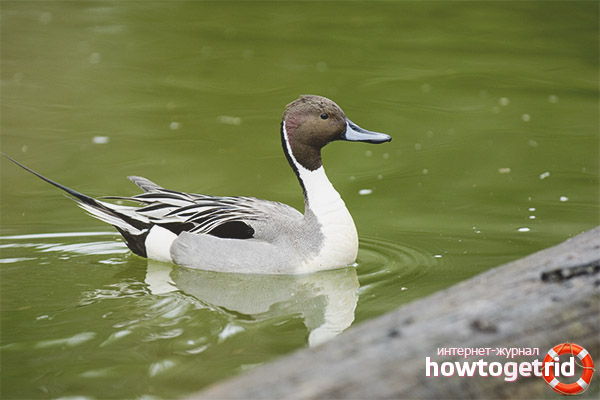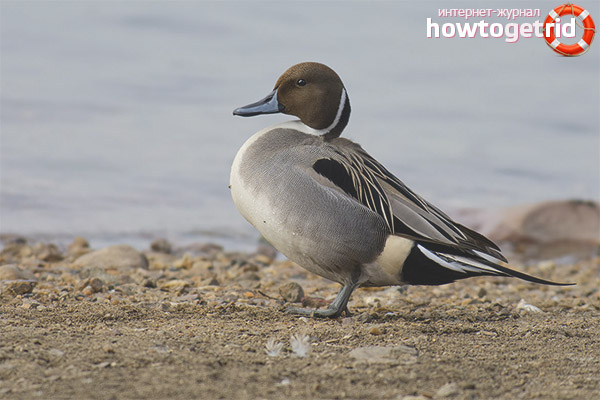The content of the article
Pintail - this is the most famous for most ordinary people and common on our planet species of ducks. Also, many people know this waterfowl under such names as wadtail and shilen.
Appearance Features
The pintail duck rightfully earned the honorary title of the real standard of waterfowl. The average weight of this duck is about 1-1.2 kg. In this case, the drakes are slightly larger than the females. The lengths of these birds reach 56-58 cm. Wingspan - 85 cm.
I would like to draw attention to the fact that due to the structural features of the body shape of this duck, it can be confused with other, larger species. This is due to a too long neck and a curved tail. Nevertheless, the structure of the pintail is very elegant, which distinguishes it from other types of waterfowl. Often this species is called the most spectacular and beautiful among all types of ducks.
Unlike females, males have more beautiful and rich colors. Directly the body itself is gray with a white abdomen, a yellow-black undertail and dark green accents on the neck. The head has a plumage of brown or chestnut color.
Of course, such brightness and juiciness of the plumage of the male appears only during the mating season. The main difference between the female and the drake is the lighter color of the beak and the constant, gray color of the plumage.
Bird Voice Features
Lifestyle
Although the duck is a sharp-tailed duck and swims well, nevertheless, it does not like to dive too much. This is because she does it rather ineptly and badly. Even if the bird is chased by a predator or if it is injured, the duck will try to escape only by swimming, not diving. The flight of this type of waterfowl is also peculiar - they fly, stretch their neck, from the side it seems that they, therefore, inspect the terrain over which they fly.
Despite the fact that pintail belongs to the species of waterfowl, nevertheless, this duck feels great on land, as evidenced by its ability to run fast. As a rule, this type of waterfowl does not live in large schools. The exception in this case is the migration period and molting time. At such a time in a flock of birds can be up to several thousand individuals.
It should also be noted that the pintail does not apply to territorial birds, that is, the couple does not have their own land for living and protecting their own territory. As a rule, they settle far from the place of their birth. This, in turn, contributes to the spread of this species on new lands.
Duck food
The pintail duck can eat a variety of foods - aquatic plants, duckweed, grass, insects, small fish. We note that in most cases, the food of the oxtail directly depends on the habitat - that is, it may be an abundance of animal feed or the predominance of plant foods in the diet.
The main food for pintail can be attributed to: mollusks, algae, various aquatic plants, larvae of the inhabitants of reservoirs.
Propagation Features

Particularly noteworthy is the fact that duck pintail does not start a permanent partner, that is, a pair created is a temporary phenomenon. If steam is created, then, as a rule, the most suitable time for this is the end of the cold season.
As with most birds, the main task of the male is to attract the female, which is manifested by all kinds of signs of attention (characteristic voice “calls”, prolonged swimming of the drake around the female “circles”). If the drake has achieved a result, a pair of ducks sets sail a certain distance from other individuals.
To lay eggs, the female oxtail independently chooses a suitable and protected from prying eyes place. As a rule, this is a nook on the surface of the earth, often in thickets of tall grass or in bushes. Eggs are laid in a prepared hole, the bottom of which is lined with dry vegetation and down.
The average number of eggs laid by a pintail female is no more than 10. Only the female of the tailtail is engaged in the process of hatching offspring, its duration takes about 3 weeks. When a duck should leave in order to eat, it always covers the eggs, hiding them under dry foliage. Hatched chicks are able to swim almost immediately, which, in fact, they begin to do. As a rule, the period during which the parents of the ducklings carefully monitor them is the first three months, then the young ducks become more independent.
Natural habitat
In our country, this duck is the most common, as evidenced by its fairly large population. The nesting sites of the wolftail are mainly islands, steppes, taiga, and marshland of the tundra.
An interesting fact about the Pintail! This waterfowl is the fastest among many species of ducks, as it is capable of developing a fairly high speed - up to 80 km / h.
Video: pintail (Anas acuta)










Submit